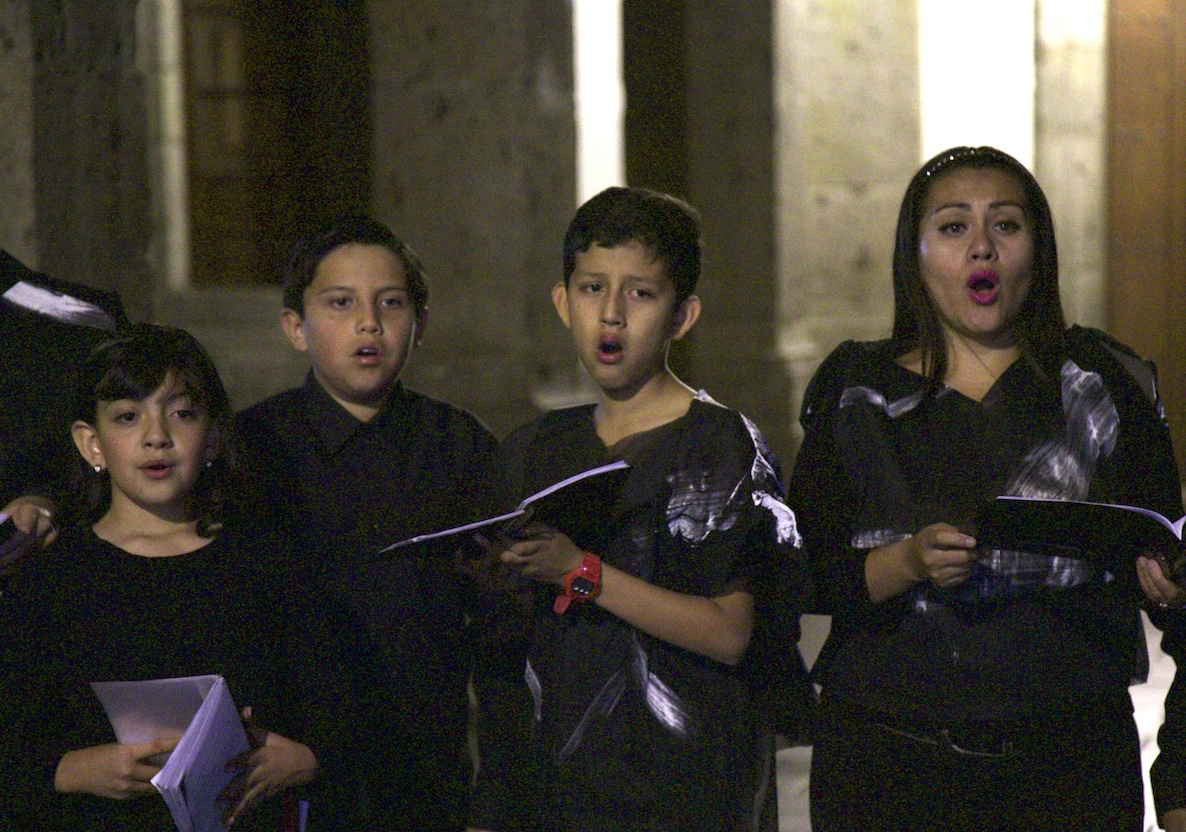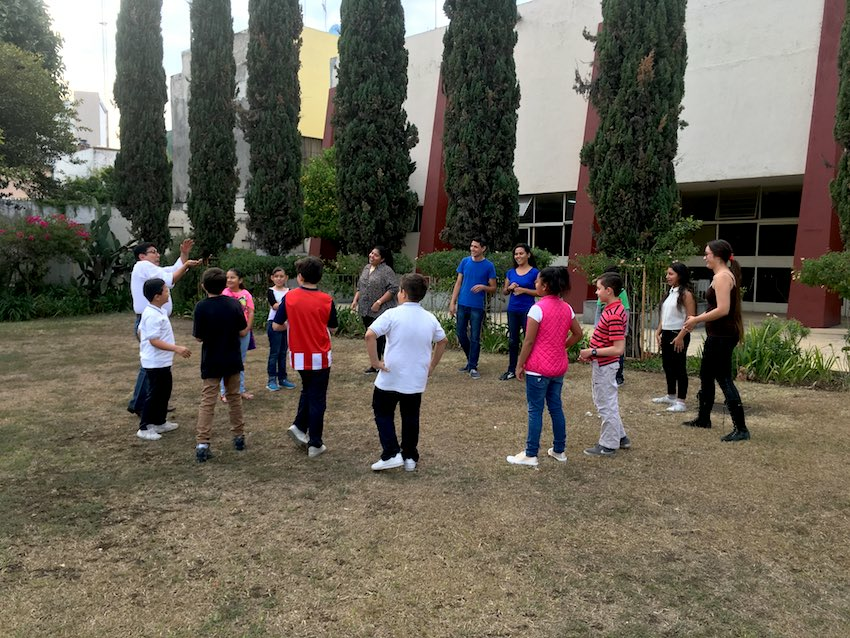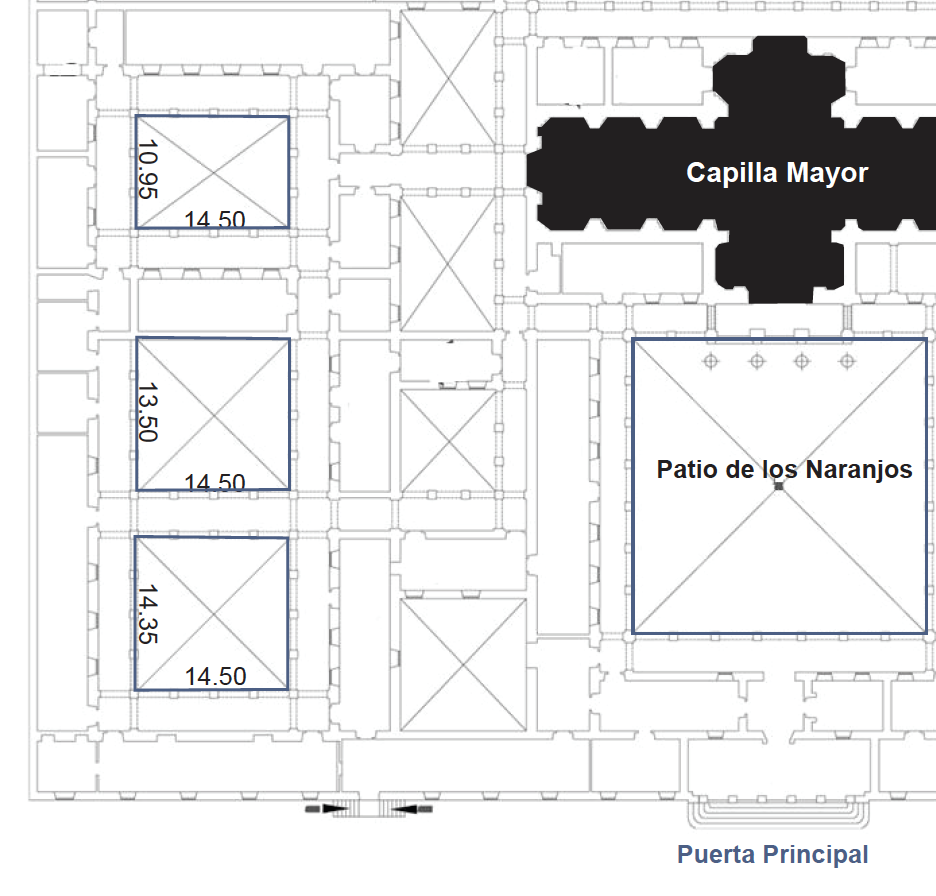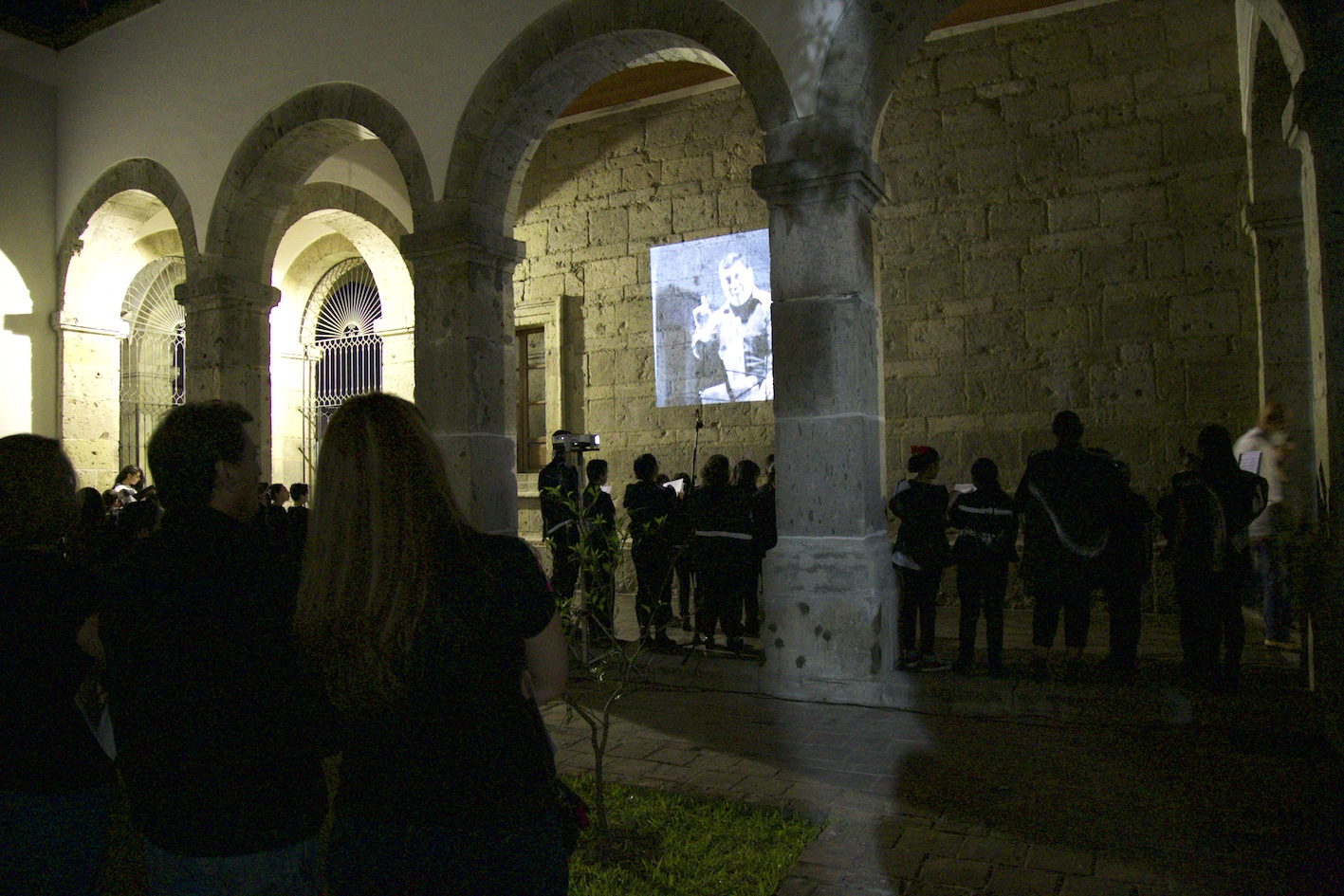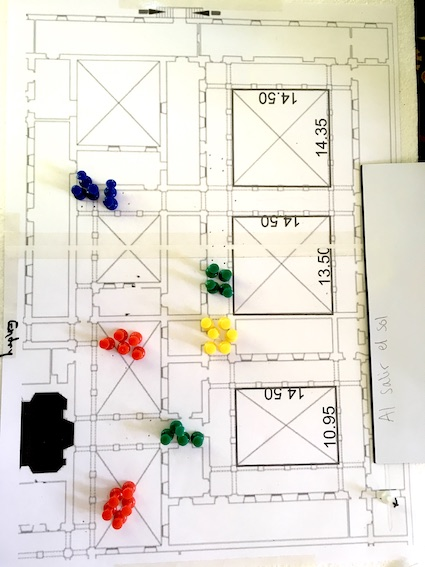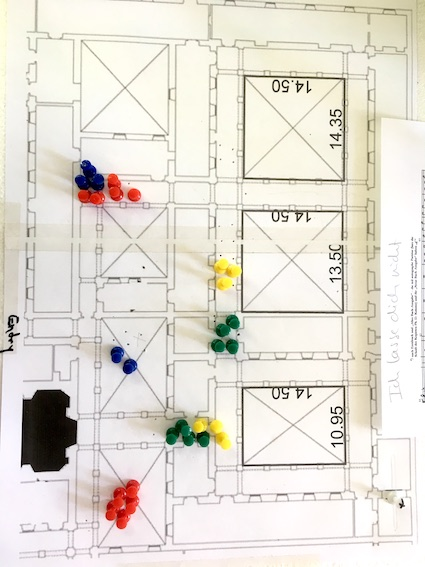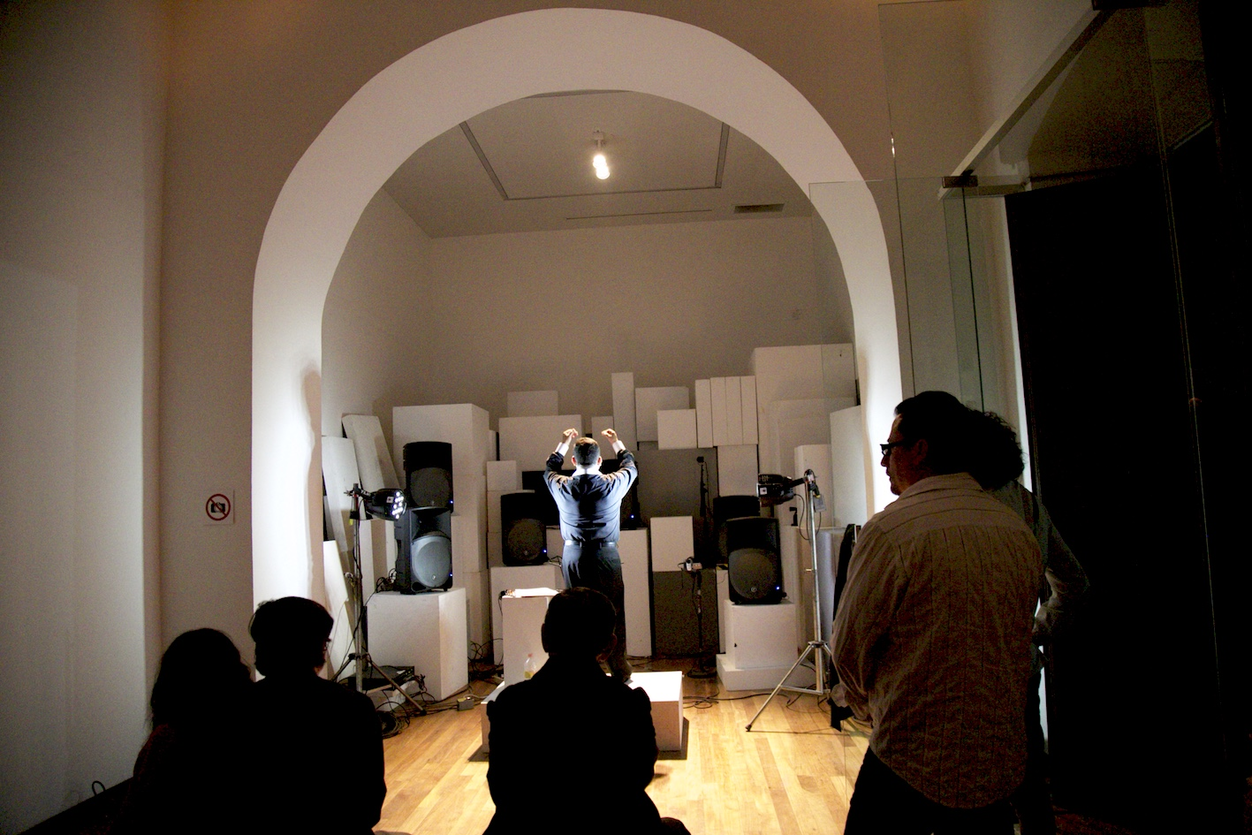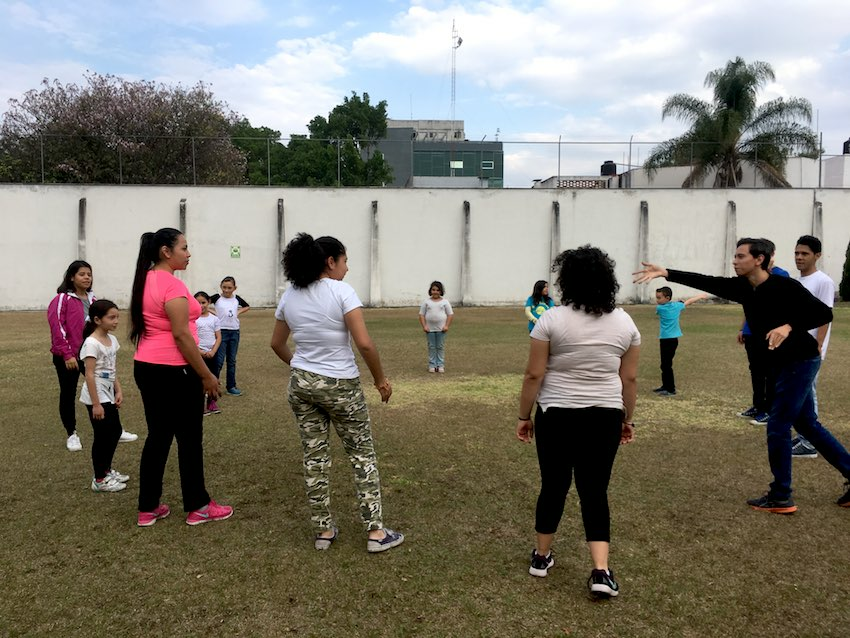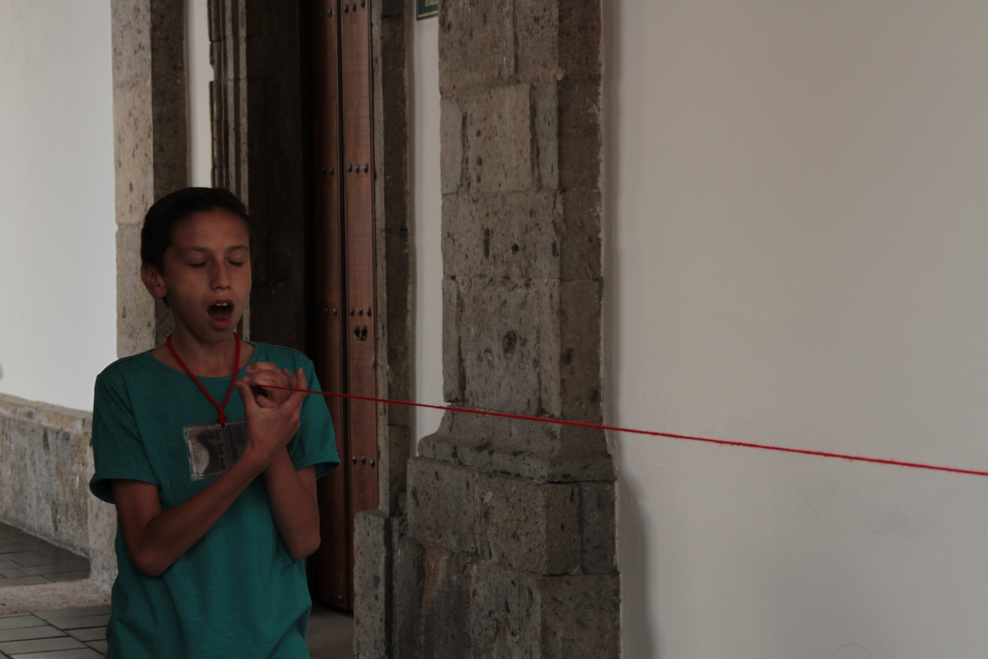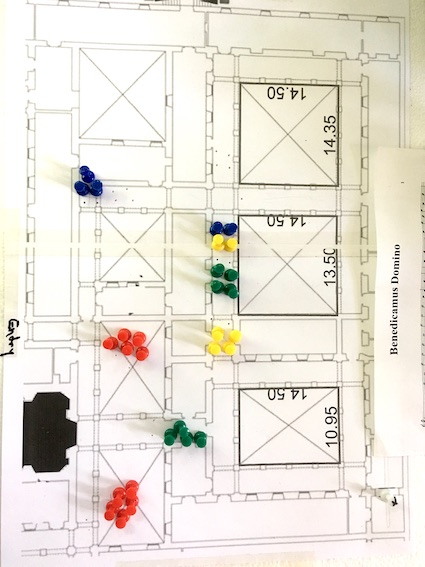The complete performance was only documented in audio. This trailer can, however, give some further impressions from the performance.
Filmed and edited by Beatriz Barragan Horn
In the museum Instituto Cultural Cabañas, I created a performance with the youth choir of the Cathedral of Guadalajara. The choir consisted of 80 singers. For this performance we used sacral music from the archive of the cathedral. Instituto Cultural Cabañas used to be a hospital complex and is now a modern art museum. Its entangled architecture allows for paths between closed and open spaces (patios). In Vokal-De-Konstruktion the spatial de-construction of the music revealed its structure and allowed for the audience to walk through the architecture of the music. The different voices of the choir were distributed between different parts of the building. In addition to placing the singers, I arranged for moments when singers moved along a certain path while they were singing or quiet. By spatially distributing the elements of the music in this way a re-construction or rather neo-construction of the music in the space, in collaboration with the architecture, occurred. In order to connect the singers to the conductor, he had his own room where live sound was sent from each voice space to a different loudspeaker. In front of him, next to each speaker, was a camera. This way he could conduct the individual voice groups and connect the singers. In turn, the singers received different visual outputs of the conductor that were designed by scenographer Natalia Orendain.
Voice as an extension of the body
In site-sensitive works the body enters a dialogue with the architecture of the space. The sonic extension from the physical body therefore needs to be introduced to the questions of how we send the sound, and where we send it to and from. In order to practice this, the singers explored the performance space with their voices in small groups. They varied how they related to the architectural elements and they changed the distances between each other repeatedly in order to hear the differences. When they understood their dialogue partners better, they started to play within their vocal range and made small site-sensitive improvisations.
There is another game that I always play with singers. One singer forms a sound-ball and throws it. When another singer catches the ball, the sound of them receiving it should react to the sound-ball that was sent. Then the ball can be transformed into a different sound and be passed on. (This game is described in more detail in Composing in Space.)
People understand through people
When being watched and listened to, the performer is subject, not object. Each choir member is an individual. They share their voice and presence with the audience, and in so doing they create an experience for the audience. Simultaneously they are creators of their own experience. Through their gaze the performers can confirm kindly: “I am here singing, and you are there watching and listening. We do this together”. In general, the performers can help the audience to feel comfortable looking at them. They can do this through a generous welcoming presence and an attention to their surroundings.
The singers create space for the audience. Physically they can move, and through the sound of their voice they can embrace the audience or lead them/their imagination somewhere. The movement of individual singers and groups of singers through the space makes clear that this performance is in constant movement. This can motivate the audience to move as well.
In Vokal-De-Konstruktion I was interested in the spatial separation of the choir in order to make the structure of the music physically accessible. At the same time, I wanted to bring the audience closer to the individual performer, and to make the body an essential feature of the vocal performance. This attention to physical presence for the performer and the audience was enabled by the movement of the performers and by giving the audience the freedom to move in the space. Vokal-De-Konstruktion is, in some of its strategies, related to Forty Part Motet (2001) by Janet Cardiff. For her reworking of Spem in Alium by Thomas Tallis (1573), Janet Cardiff recorded each voice in the choir in order to project their voices through separate loudspeakers on stands, which were placed together in a space. With this work Janet Cardiff freed choral music from its traditional setting as a frontal performance and she allowed the visitor to her work to experience the individual voices of each choir member. Through this deconstruction Cardiff allows the audience to enter the music that to her in the score looked "almost like water in a river moving around" (Tate, 2017). On her webpage she writes that she "placed the speakers around the room in an oval so that the listener would be able to really feel the sculptural construction of the piece by Tallis" (Cardiff, 2001).
The motivation to create Vokal-De-Konstruktion for me and my collaboration partner Natalia Orendain is in line with Janet Cardiff’s work as we aimed to make the spatial structure of already existing music available for an embodied experience. The intimacy that the individual voice holds is, in Forty Part Motet, transported by disembodied technology that creates a virtual sonic space in a real space. As much as the music itself is moving and the audience can move in it, the virtual space that is created through this arrangement is fixed. With the use of technology comes a feeling of safety for the audience in a way that allows them to overcome individual boundaries more easily than when encountering a real person who sings. However, it inhibits a more embodied engagement. The human relation may develop among audience members but the voice behind the speaker is unreachable. Even when we can listen to the intermission between the recordings of Spem in Alium, we stay behind the Pythagorean curtain. An acknowledgment of each other’s presence and the interaction with the space are missing when the body of the performer is absent. As the sound is pre-recorded and its sonic space is conceptual, Forty Part Motet is not intended to interact with the acoustics in the space and the living sonic surroundings in real time during the performance. The interaction between the singers and the acoustics of the space in Vokal-De-Konstruktion form a core part of the exploration of the spatial structures in the music. (For further information refer also to Music and Architecture and The music inside space and the space inside music)
The performer’s presence
The vocal performance Vokal-De-Konstruktion was informed by the tradition of youth choirs. The attentiveness and presence that was demanded in this performance was unusual for the choir members. The responsibility a performer has in a site-sensitive spatial musical performance became evident in this context.
The silent performer
Silence in choir performances can become visible in addition to being audible because singers let their score sheets sink, their eyes search around, clothing is adjusted etc. In Vokal-De-Konstruktion silence is a compositional parameter. Through the dismantling of the choral structure in the space, the silences of the distinctive voices that are part of the original choral compositions become more evident. In order to care for these silences, the singers were asked to stay in the music with their attention and presence when not singing. Ways of visually connecting to the music included watching the conductor, reading the notes of the other voices, or listening consciously to the unfolding of the music. Some singers found joy in watching how the audience discovered the piece. This attention towards the audience is another way to be present and attentive during parts where one does not sing.
Connected to this is the understanding that silence is more than being quiet or “not doing anything”. During our rehearsal time, we did some exercises in order to reflect on this aspect and explore and discuss the differences. For example, the singers performed in small groups for each other and gave feedback on what they enjoyed in the presence of the group, and of individual performances in that group. Especially for the small children it was important to understand that when they look bored or search for things to occupy their mind, they take some pleasure of the experience away from the audience.
In the dramaturgy, silence was sometimes introduced as a possibility to tune down to a zero. This meant a moment of stillness for the performers, the sound, the space, the audience. It created a point where anything could happen next and enabled a refreshed receptivity.
As the performers also provide indications for the audience on how to be in the performance space, it was an important realisation for me that in silence one can show that one is listening. When the audience sees that the singers listen to the music, they listen more closely.
Incognito performers
The one-hour performance was too long for the smaller children of the choir. In the first half of the piece the children’s choir (age 6-10) was therefore a part of the audience. The best way for them to be in it was to be good examples for the audience: move slowly, stay and listen carefully, enjoy themselves without distracting others. I would like to mention that having incognito performers is a manipulation that I would generally avoid. In this performance, however, I did not want the children to wait backstage for 30 minutes until it was their turn. I wanted them to be a part of the whole.
During this first part there were supervisors for the children. On a small scale the supervised groups showed what I have observed in a bigger scale in the audience of other performances: the more concrete and stricter the guidance, the less organic the group become. The more freedom the children were given by their supervisors the more they explored the piece in their own way, the more they became a part of the whole while obviously enjoying themselves more.
The small children also gave feedback to the older choir members after the premiere. This was very helpful for the singers, because they trust their fellow singers and they were more confident when they performed the second time. And the small kids clearly enjoyed the fact that their opinions mattered to the older ones.
In spatial sound performance the fact that voice is a tool that can reach a person who is not looking, and who may not even be in the same space, is very important. This advantage that sound has over sight brings creative potentials to live vocal performance.
In the choreography of sounds, I use the extension of the body through sound in a dynamic and three-dimensional way. In order to help the singers understand this notion, I developed some games for them at Instituto Cultural Cabañas. The singers received balls of wool. In small groups they could draw with the wool in the space where they thought the sound reached.
Back to the portal
Positions and movement of the singers (each voice group has one colour). Conductor in the bottom right corner.
In the varying architecture of Instituto Cultural Cabañas the aural and visual perspectives are often alternately limited and expanded when moving through it. During our rehearsals, I walked through the spaces in order to find out if the mode or direction the singers sang would have to be adjusted in different parts of the performance. With small adjustments the music became more spatial in a way that related to its internal logic and at the same time brought out certain acoustic characteristics of the space.
The voices of the singers were also the spatial guide in the performance. They attract the audience, lead it, stimulate its curiosity, choreograph its perception, and create spaces to land in. (see landing in the dictionary)
The audience had to deal with the extended body created with the performers’ voices and had to relate to it with their own body (See also The Body of Sound book and in the dictionary). Additionally, the audience members were able to adjust physically to their own aural sensitivity and preferences. In Vokal-De-Konstruktion the audience could always evaluate the experience they had in real time. At any moment they could move and change their experience. Possible negotiations were, for example, the proximity to the singers, one’s movement in a space and between spaces, and the extent of their immersion. The choices the audience members could make during this spatial musical performance were open and could be adjusted as often as desired.
